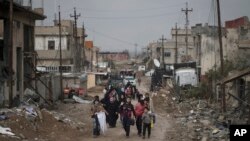It was known as the the Pearl of the North.
Mosul traces its history to the 25th century B.C., and for 13 centuries it was ruled by Assyrians, becoming at one time an even grander city than Babylon.
Then known as Nineveh, and located 30 kilometers north of modern Mosul, it was a key city in Mesopotamia, a cradle of civilization that is credited with such profound developments as the invention of the wheel, the first planting of cereal crops and the first use of cursive script. The origins of modern medicine and mathematics can be traced to the city. Early Sumerian inhabitants were among the first to pose existential questions such as: Who are we? Where are we? How did we get here? These helped to shape ancient Greek philosophy and, subsequently, our modern world.
But the Pearl of the North, like the whole of Mesopotamia, has also seen more than its share of devastating wars that pitted tribes, races, religions, countries and empires against each other in terrible cycles of conflict, revenge and retaliation. The word Mosul means "linking point" and, sitting astride a route linking northern Mesopotamia with Anatolia, it has lured conquering armies.
On Tigris' west bank
Since the 7th century, the city has stood on the west bank of the River Tigris, opposite the ancient Assyrian city of Nineveh on the east bank, where it attracted an influx of Muslim Arabs, Kurds and Turkic tribes. In 637, the city was annexed to the Rashidun Caliphate by Utba bin Farqad Al-Salami. It grew to encompass both banks, although Assyrians defiantly still call Mosul Nineveh or Ninweh. In 1538, Sultan Suleyman the Magnificent captured Mosul from the Persians, adding it to his Ottoman Empire.
With the defeat of the Ottomans in World War I, British forces occupied Mosul and put into effect a secret 1916 land deal between London and Paris to carve up the Turkish empire. The Sykes-Picot Agreement defined Iraq's modern borders, creating a country that awkwardly grouped Kurds with Sunni and Shi'ite Arabs, Assyrians and Yazidis. A monarchy was established, and in 1932, Iraq gained independence from Britain.
Split across borders, ethnic and religious groups chafed at the colonial reordering of the map of the Middle East. Under the dictatorship of Saddam Hussein and the Ba'ath Party, the rearranging continued. Mosul and its outlying province, like other parts of northern Iraq, witnessed a major demographic shift, involving forced displacement campaigns by Baghdad to reduce the size and cultural influence of indigenous minorities — Kurds, Yazidis, Assyrians, Shabaks, Armenians, Turkmen and Mandeans.
The government made concerted efforts from the mid-1970s onward to expel minorities and to encourage Arab settlers. An estimated 200,000 Kurds were displaced to other parts of the country in 1978 and 1979 alone.
Decades later, when sectarian violence erupted after the U.S.-led invasion of Iraq and the ouster of Saddam, many blamed the Sykes-Picot deal for pitting ethnic groups against each other. When the Sunni extremist Islamic State group announced its caliphate, it emphasized that it marked the end of Sykes-Picot. IS even posted a video of a bulldozer flattening a dirt berm marking the border between Iraq and Syria.
U.S.-led invasion
The 2003 U.S.-led invasion was originally planned to start with Mosul. When policymakers drew up the war plans, they had wanted to strike from Turkey with the key northern city as the first target. But the Turks refused to approve the operation, forcing the invasion force to attack from Kuwait in the south.
Mosul fell on April 11, 2003, when the Iraqi Army 5th Corps, loyal to Saddam, fled the city two days after Baghdad was seized. U.S. Army Special Forces with Kurdish fighters swept into Mosul. Hiding in the city were Saddam's sons Uday and Qusay, killed three months later in a gunbattle with coalition forces.
Under coalition occupation, the U.S. Army's 101st Airborne Division, a civil affairs battalion and NGOs started to oversee the reconstruction of Mosul. U.S. soldiers quickly ended an early insurgency against their presence.
But security in the city started to deteriorate within months, and on June 24, 2004, coordinated car bombs killed 62 people. By November, Mosul, like other parts of Iraq, was rocked by twin insurgencies by Sunni and Shi'ite groups. In Mosul, the biggest challenge came from a violent Islamist group called Jamaat Ansar al-Sunnah, a coalition of Sunni Arab and Sunni Kurdish fighters, aligned with Abu Musab al-Zarqawi and his Jama'at al-Tawhid wal-Jihad. The group, also known as al-Qaida in Iraq, a forerunner of Islamic State, seized control of Fallujah, Ramadi, Samarra and Baquba.
A month later, 14 U.S. soldiers, four American contractors and four Iraqi soldiers were killed in a suicide attack on a mess hall at a coalition base. From then on, Mosul was never truly free of insurgents.
Bombing, assassination
In 2008, security deteriorated further. On January 23, 2008, 36 people died in an explosion in an apartment building. The next day, a suicide bomber assassinated local police chief General Salah Mohammed al-Jubouri as he toured the blast site.
In May, the U.S. backed an Iraqi army offensive commanded by General Riyadh Jalal Tawfiq, hoping to suppress insurgents. That year, 12,000 Assyrian Christians fled Mosul after Sunni insurgents murdered more than a dozen of their faith and threatened to kill any Christians who failed to convert to Islam.
That was a taste of what was to come when IS attacked Mosul in June 2014 and, after declaring a new caliphate, unleashed a wave of terror against Christians, Yazidis and fellow Muslims.







